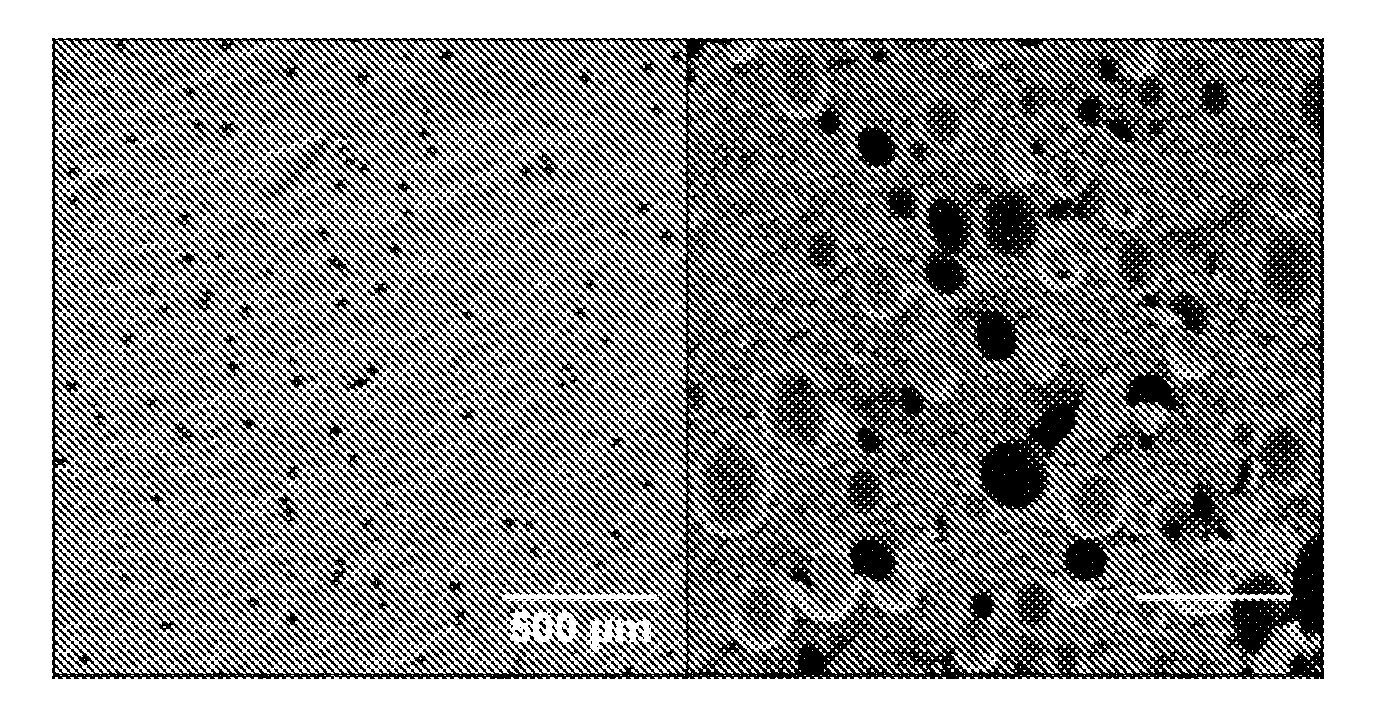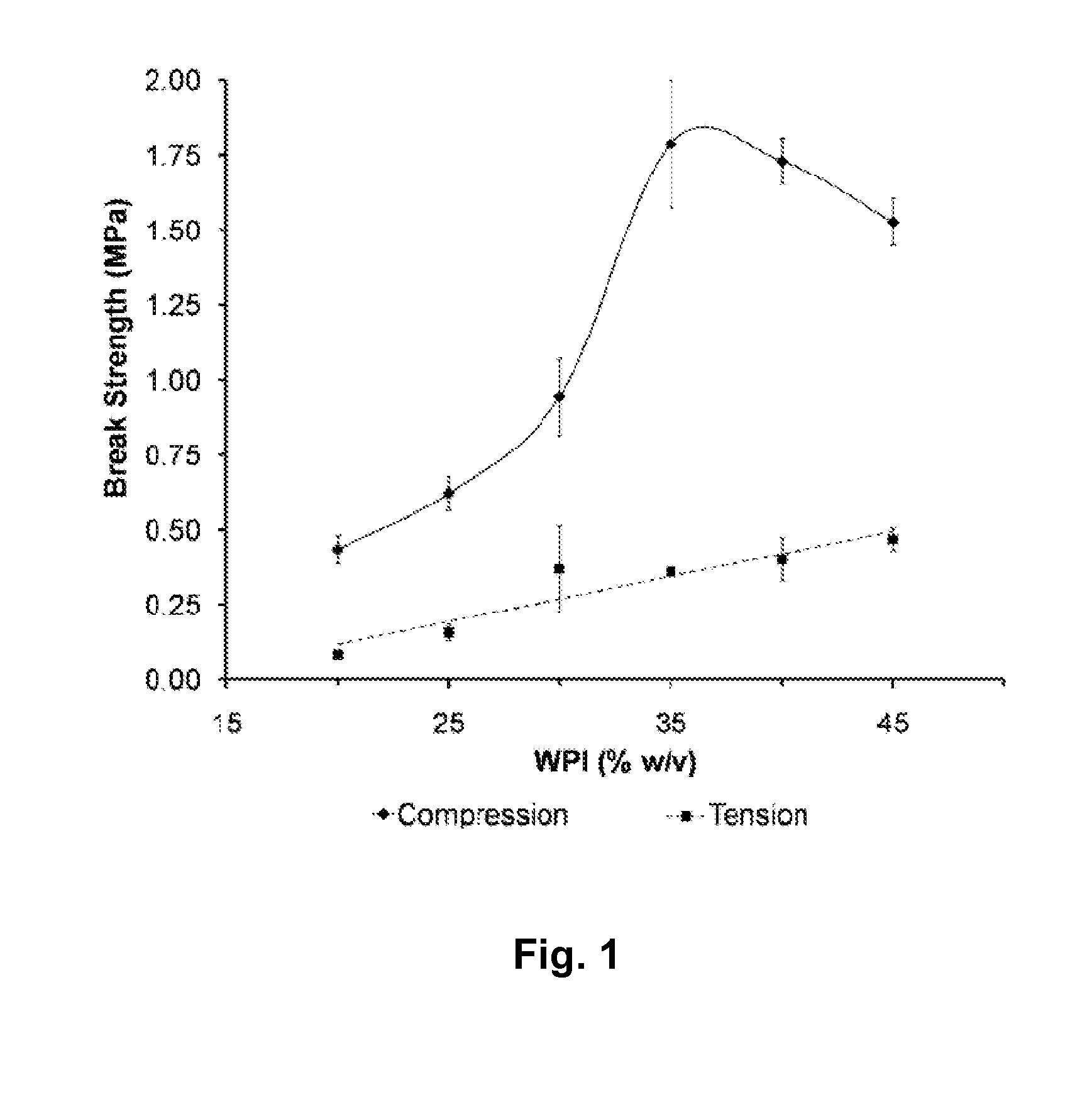Whey Protein Isolate Hydrogels and Their Uses
a technology of whey protein and hydrogel, which is applied in the direction of prosthesis, angling device, plasma/lactoglobulin, etc., can solve the problems of inability to find the ideal material, lack of compressive strength to be applied to bone regeneration, and difficulty in finding the ideal material
- Summary
- Abstract
- Description
- Claims
- Application Information
AI Technical Summary
Benefits of technology
Problems solved by technology
Method used
Image
Examples
example 1
Mechanical Properties of the Naïve Gel
[0068]Materials:
[0069]All water used in this work was >18 MΩ polished water from a Direct-Q 3 water purification system (Millipore, Billerica, Mass.). The materials used were Whey Protein Isolate (WPI) powder from Davisco Foods International (Eden Prairie, Minn.), where powder composition was: beta-lactoglobulin 68-75%, alpha-lactalbumin 19-25%), bovine serum albumin 2-3%, immunoglobulin 2-3%; calcium chloride dihydrate from Maliinckrodt Chemicals (Hazelwood, Mo.); and phosphate buffered saline solution (NaCl, KCl, Na2HPO4, KH2PO4 from Sigma-Aldrich, St. Louis, Mo.). MC3T3-E1 subclone 4 preosteoblast cells were purchased from ATCC (Manassas, Va.), and αMEM, penicillin / streptomycin, fetal bovine serum, and Fungizone from Invitrogen (Carlsbad, Calif.).
[0070]Scaffold Fabrication:
[0071]Samples for material testing were prepared by adding WPI powder to an aqueous CaCl2 solution of half the volume and double the concentration desired for the final mix...
example 2
Concentration Effects of Calcium Chloride
[0091]Mechanical Properties:
[0092]Using methods as described in Example 1, two sets of gels were tested to failure in compression. One was at 30% w / v WPI, and the second at 35%) w / v WPI—the concentration resulting in the highest observed mechanical strength. The effects of calcium chloride on the compressive strength of the material were evident but difficult to quantify, since gels made with a concentration greater than 20 mM CaCl2 compressed uniformly to greater than 90% deformation without failure. FIG. 4 shows a plot of mechanical strength versus calcium chloride concentration. The curves represent stress at failure under compression of 30% w / v WPI and 35% w / v WPI, and under tension of 30% w / v WPI and 40% w / v WPI. The inlay plot is a clearer view of the tensile results. The results for gels of lower concentration demonstrate an optimum strength, observed at 1.66±0.34 MPa, corresponding to a concentration of 7.5 mM CaCl2 and 35% WPI (FIG. ...
example 3
Curing Time Profiles for WPI Gels
[0100]The time to cure the sol-gel precursor solution was determined by varying the cure times of gels of a representative composition. FIGS. 9A-9C shows the mechanical properties of WPI gels as a function of cure time, with FIG. 9A showing compressive strength. FIG. 9B showing compressive modulus, and FIG. 9C showing break strain. The optimal cure time will depend on the volume and surface area of the desired geometry. For the geometry tested is FIGS. 9A-9C (D=1 cm, L=5 cm), the cure time selected was 60 minutes, since it was the shortest time that yielded the best properties. The results can be translated qualitatively to other gel geometries, since the optimal cure time depends on the characteristic length of the gel. In a cylindrical sample of aspect ratio greater than one, as in this experiment, the characteristic length is the radius. A rule-of-thumb that can be used is 12 minutes of cure time per millimeter of characteristic length.
PUM
| Property | Measurement | Unit |
|---|---|---|
| elastic modulus | aaaaa | aaaaa |
| compressive strength | aaaaa | aaaaa |
| pH | aaaaa | aaaaa |
Abstract
Description
Claims
Application Information
 Login to View More
Login to View More - R&D
- Intellectual Property
- Life Sciences
- Materials
- Tech Scout
- Unparalleled Data Quality
- Higher Quality Content
- 60% Fewer Hallucinations
Browse by: Latest US Patents, China's latest patents, Technical Efficacy Thesaurus, Application Domain, Technology Topic, Popular Technical Reports.
© 2025 PatSnap. All rights reserved.Legal|Privacy policy|Modern Slavery Act Transparency Statement|Sitemap|About US| Contact US: help@patsnap.com



